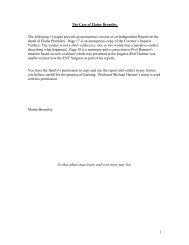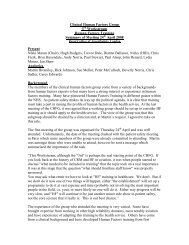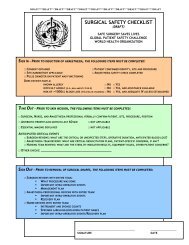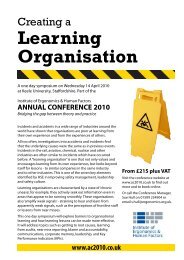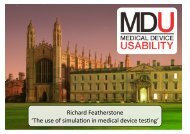The Essentials of Patient Safety - Clinical Human Factors Group
The Essentials of Patient Safety - Clinical Human Factors Group
The Essentials of Patient Safety - Clinical Human Factors Group
Create successful ePaper yourself
Turn your PDF publications into a flip-book with our unique Google optimized e-Paper software.
<strong>The</strong> <strong>Essentials</strong> <strong>of</strong> <strong>Patient</strong> <strong>Safety</strong><br />
<br />
argues for an alternative to the rigid, proceduralised, technocratic driven view <strong>of</strong><br />
safety that more truly reflects the realities <strong>of</strong> clinical work (2). Proponents <strong>of</strong> this<br />
view are rightly extremely impressed by how <strong>of</strong>ten outcomes are good in the face <strong>of</strong><br />
extreme complexity, conflicting demands, hazards and uncertainty. Making healthcare<br />
safer depends, on this view, not on minimising the human contribution but on<br />
understanding how people, look ahead, overcome hazards and, in effect, create safety.<br />
<strong>The</strong>se approaches are discussed in the following chapter.<br />
Quality improvement<br />
Manufacturing industries have made huge gains in safety, efficiency and costeffectiveness<br />
by close attention to the design, maintenance and performance <strong>of</strong> the<br />
processes used in factories. Rather than inspect products afterwards to identify<br />
defects, those concerned with quality control and management sought to build quality<br />
in to the process (3). <strong>The</strong> report on the British NHS by Lord Darzi similarly puts<br />
quality at the heart <strong>of</strong> the NHS does and makes it clear that everyone should play their<br />
part in promoting and driving higher quality care for patients (4). In healthcare this<br />
has become as aspiration but not yet a reality.<br />
Doctors, nurses and others <strong>of</strong>ten find it hard to understand that approaches<br />
developed in manufacturing can have any relevance to healthcare. We deal with<br />
patients as individuals, how can we learn anything from companies that make cars In<br />
fact <strong>of</strong> course cars and computers can now be completely customised and matched to<br />
individual needs and preferences. Healthcare is also full <strong>of</strong> processes, <strong>of</strong> varying<br />
degrees <strong>of</strong> complexity, which are very akin to manufacturing processes: pharmacy,<br />
ordering test results, the blood service and so on. <strong>The</strong> methods <strong>of</strong> quality management<br />
are well described in many books (3, 5). Quality methods are sometimes presented<br />
simply as a set <strong>of</strong> tools and techniques, but properly conceived the various systems<br />
aim at substantial and enduring organisational change based on principles and values<br />
that each organisation must define for itself.<br />
Simplifying and standardising the processes <strong>of</strong> healthcare<br />
Compared with manufacturing industry healthcare has little standardisation,<br />
comparatively little monitoring <strong>of</strong> processes and outcome, and few safeguards against<br />
error and other quality problems (6). Most healthcare processes were not designed,<br />
but just evolved and adapted to circumstances. Many healthcare processes are long,<br />
complicated and unreliable. <strong>The</strong> process <strong>of</strong> prescribing, ordering and giving drugs is a<br />
good example <strong>of</strong> complexity and lack <strong>of</strong> standardisation. David Bates gives an<br />
example <strong>of</strong> the problems that he observed in his own hospital before a sustained<br />
attack on medication error and adverse drug reactions:<br />
pital several<br />
years ago, which was similar to that used in most hospitals at the time.<br />
Physicians, medical students and nurses all asked patients what their allergies<br />
were. This information was recorded at several sites in the medical record,<br />
though there was no one central location. <strong>The</strong> information was also required to<br />
be written at the top <strong>of</strong> every order sheet, although in practice this was rarely<br />
done. <strong>The</strong> pharmacy recorded the information in its computerised database,<br />
but it found out about allergies only if the information was entered into the<br />
orders, and <strong>of</strong>ten it was not. Checking by physicians, pharmacy and nursing<br />
29



